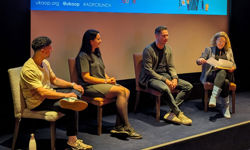Would you like to double the size of your sales and marketing team with no additional capital outlay? Yes? This can be done quite simply - by getting your editors and reporters to think like marketers. I would like to concentrate on the relationship between ‘editorial’ and ‘newspaper sales and marketing’ to show how a strong bond between the two can create a stronger sales platform and greater commercial success.
Editorial training
Most editorial staff come to the newsroom via a media degree and then work towards a recognised journalism qualification, to teach them the fundamentals of the job. I believe that adding a commercial element to their training, and introducing them to newspaper sales and marketing would help them understand that the publication exists not only to serve its chosen community, but also to make a profit.
We all know the sales boost returned from a big story; a town centre fire or a good football result can put on over 5%, but, alas, these cannot not be relied upon to happen on a regular basis. Local grass roots news does, however, happen everyday, and it is spotting the potential of these stories and making the most of them on a daily basis that will give your publication the edge.
Most publications split their reporting teams between areas of the community. Their stories form the basis of the newspaper each day and will vie with each other on the daily news list, jostling for position depending on their news worthiness. The story will appear, another publication week will disappear and the resultant sales of the paper in general will be published unnoticed, except to the chosen few.
Patch reporting
In my last role in newspaper marketing we started to use a more scientific approach to this procedure, giving news reporters greater accountability. This injected added competition to the news operation and highlighted the all important link between editorial and sales.
The project was presented by the editor and myself to the newsroom. All staff were briefed and reporters were designated news areas, much as before. The big difference was the way the areas were judged. Sales figures were published for each reporter’s ‘patch’ every week. For the first time they could see the effect their stories had on sales on a regular basis.
This led to stories such as a local bus route closure being scrutinised alongside the bigger football led agenda, with the local story beating its bigger rival in the area of the community most affected. Such smaller stories, whilst not front page material, were then put up for a skybox teaser, newsbill subject, or, at the least, a targeted leaflet campaign to the 3-400 homes that were most affected by the story.
These in-house printed leaflets detailed the headlines of the story and were distributed to non 6 day delivered readers in the targeted areas on the day, or day before, publication. They also listed all local newsagents and some carried a money off voucher to encourage readership beyond that day’s sale. The use of such leaflets would lift sale by anything from 20-50% in the given area, just by telling local people about local news in their area.
Newsbills from the day were written to reflect the stories and each bill was hung up in the newsroom close to the corresponding journalist. All editorial staff were asked to put up contenders for newsbills on a daily basis. This led to a healthy competition for stories as their work was not only published but marketed, and they were part of the whole process.
The marketing department were always on hand to take the editorial staff through the sales figures for their patches. Bottles of wine were offered to the best performing stories and to the reporter who had come up with the best story of the week.
Extending the concept
Local news patches are easier to define in sales value, but you can repeat the process with specialist reporters such as crime, entertainment, sport and health.
This will make the crime reporter hungrier for a scoop, the entertainment reporter keener to break the hot new tour dates before radio, and will keep the health reporter focussed on the hospitals, for news of outbreaks or closures.
For some reason Daniel O’Donnell attracts thousands of regional newspaper readers to his concerts. A Dan story puts sale on, a free Dan badge and in-paper poster will add still more. If you can leave your ents reporter to organise and plan some of this activity (alongside the marketing department), then brilliant.
Once you have this set up, the process can be stepped up a gear by taking out the most ambitious members of the news and marketing teams and involving them all in the sales and marketing process for the following year.
Start to make a list of what this forward thinking team can look at. Here are three of the most obvious:
1. Campaigns.
You can set up and target likely editorial campaign types for the following year. This can be anything from a new crossing on a busy road to a local hospital closure.
Although the specific story may not be known in advance, the template of how to deal with a type of story can be written. Most local micro campaigns can put on around 100 sales a day, and with clever use of materials such as posters, stickers, newsbills, placards, petitions, e-mail, text lines and, of course, the reporter from the newspaper, it can be more. Be ready with your plan to hit first using some or all of the techniques listed and you will lift sale and also the status of your title in the area most affected. The great thing about campaign marketing is that it can be done with little or no cost, giving all titles the chance to gain crucial extra sales.
An example of this was a campaign that ran in Norfolk against the planned closure of a local hospital, led by the local reporter and backed by the editor and marketing department. Posters, badges and petition sheets were printed up and the campaign was given great coverage in the edition area, which led to a rethink and a delay in the decision to close the hospital.
Anytime an update to the story was published the newspaper gained an extra 100-200 sales, giving them a 10% sales increase in that particular area. The local reporter led the marketing campaign and made sure he let marketing know of any new stories or leads to continue the campaign. Not all campaigns will be won, but it is important to be first and have all staff onboard.
A campaign does not have to be for a worthy cause. It can be a celebration too: pub of the year, local people, gardens, best kept village or town etc etc. By using the newspaper as the vehicle, editorial as the driver and marketing as the microphone, your chosen campaign will become known quickly and extra sales will result.
2. New supplements / platforms.
As newspapers evolve and new supplements are launched, then the need for unity between editorial and marketing increases. A new 20 page supplement inside a medium sized newspaper will cost thousands of pounds a year to produce. To justify this new pagination you either need to increase the price of the product, decrease the size on other days or find additional funding in order for the product to go ahead.
The Evening Star in Ipswich launched a new supplement called Grass Roots aimed at children from 5-18 who participate in all forms of sport. It was 20 pages of full colour and went inside the paper every Monday. The newspaper needed to find a year long partner and many thousands of pounds to fund the project. They set up a team consisting of key members of both the editorial and marketing departments to brainstorm the whole process.
The result was a year long sponsorship deal with a London based company. It was funding which resulted from the quality of the pre editorial work and the imagination of the team in general.
In the first few weeks of publication the interest for the new project was unprecedented, especially from the very difficult-to-get young people category. Most wanted their sport or club to be featured, resulting in treasured extra newspaper sales. The feature writer had written to every sports club and organisation in the county. This is newspaper marketing in the hands of a junior reporter!
3. Reacting to news, creating sales, extending the story.
Once again, an example of how promotions do not always need to start with the marketing department. Some stories need interaction from the newspaper such as a local murder hunt, or knife attack where the paper prints ‘wanted’ posters or puts up a reward. Other less obvious stories come along which deserve similar treatment. At a busy roadside, we once put up ‘danger - frogs crossing’ signs, to stop hundreds of frogs from being killed and we installed a dedicated frog patrol reporter. It created extra sales locally and gave the brand brilliant exposure when the story was picked up by local and national TV.
Another great example of this was from the Delia ‘Let’s be having you’ rant on live TV. Both the editorial and marketing teams met straight away. With posters and car stickers produced the same day, extra sales were gained over the coming weeks.
OK, in the real word of deadlines, courtrooms, council meetings, press conferences, and the everyday hum drum of a busy newsroom, not all of the above is possible. But with a few key personnel on board, the marketing function starts to become shared, ideas and campaigns start to flourish and hopefully your sales figures start to swell.
FEATURE
Perfect harmony
Do your journalists ever talk to your marketers? Indeed, are they even in the same building? A close working relationship can, says Austen Dack, have a dramatic and measurable effect on newspaper sales.










